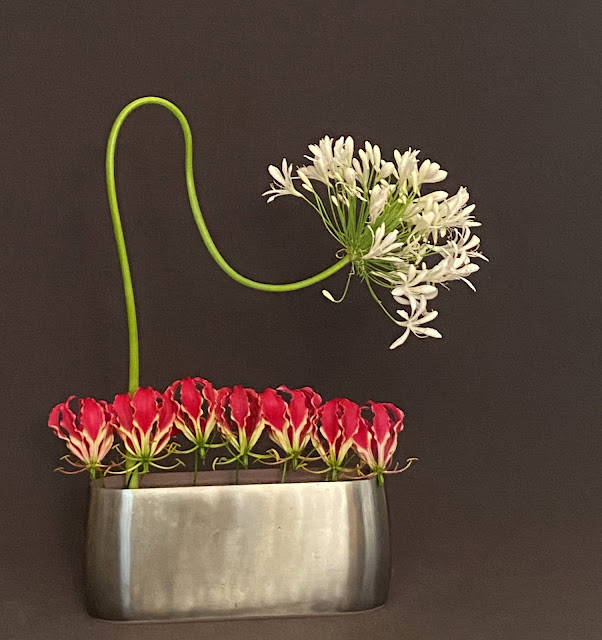Hello all,
After Christmas my family went on a weeklong holiday down south. We rented a house large enough to accommodate all 15 of us. It was not what one would call a restful getaway but it was a great bonding time for all of us. We played games, watched old family videos, cooked and ate and cooked and ate and cooked and ate some more. The little girls performed a talent quest and all the kids enjoyed the pool. The weather was not great but there were a couple of days when the beach could be enjoyed.
Dennis, my son, had hired equipment to record everyone's personal story. This was most important for mum who's 93 years old and her memory is diminishing. We loved it so much that we're planning another such trip next year.
 |
| 13 out of 15 of us |
Back home and, after taking care of home and garden, not to mention laundry, I'm enjoying using the material in the garden that had flowered whilst I was away. Case in point, the arrangement at the top of this post. I had so many gloriosa lilies that I had to use them somehow. Their short stems make them difficult to use but they look effective in a row like this. The agapanthus stem adds the line and the flower a focus.And speaking of agapanthus, here's another arrangement with a curved stemmed flower and a partially unfurled, strelitzia nicolai leaf.
I made the next arrangement just to showcase this special agapanthus called 'Queen Mum'. I have hundreds of agapanthus plants of the ordinary 'garden variety' (sorry!), but this particular one I grow in a pot and it has produced only one flower, hence its position of importance.
The individual flowers are white except for a shading of blue on the base of the 'neck'.
These quaint looking berries are from a plant called Arum italicum pictum and are much loved by the birds. I had cut them and put them in a bucket before we went away for fear they would have been eaten before I returned. I used a wire covered in some sort of soft plastic to create the squiggly line and a ceramic container, which was purchased in Vietnam.
Here's an example of an arrangement using only one kind of material. The material is Stephanotis, from the greek meaning fit for a crown. And they are too! It is a slow growing creeper with woody stemmed lianas and clusters of trumpet shaped, pure white, fragrant flowers.
Some years ago I had mentioned in passing, at a class I was attending, that I wanted to buy a stephanotis. Not long after, my colleague, Joan Norbury, arrived at my door with a plant she had purchased and handed to me. Every time I handle this material I think of her and her kindness. Joan, if you're still reading my blog, thank you, again.
The next arrangement is made with materials with which I'm unfamiliar. The term 'roadsidia' comes to mind. I first heard it from colleagues in New Zealand and have now adopted it.
We've had some seriously wet weather the last couple of days. Like most gardeners, I'm usually happy when it rains because it waters the garden saving me hours of hand watering and because it fills up my tanks. For me, having full water tanks is like having a full fridge. However, this wet spell has gone on a little too long and has damaged some flowers. The Port St John creeper flowers looked gorgeous a couple of days ago and now, not so much. I cut what were still reasonable before they, too were ruined.
 |
| Pretty in pink - Port St John creeper and hydrangeas |
Below is a photo of the oncidium orchid (dancing ladies) that was a gift from my brother-in-law, George and his wife, Betty last Christmas. Imagine my delight when it produced another flower stem this year. The only down side is that the flowers only last about a couple of weeks but, conveniently, they are at their best at Christmas.
 |
| A closeup of the individual flower |
Bye for now.Emily














































.jpg)
.jpg)
.jpg)
.jpg)
